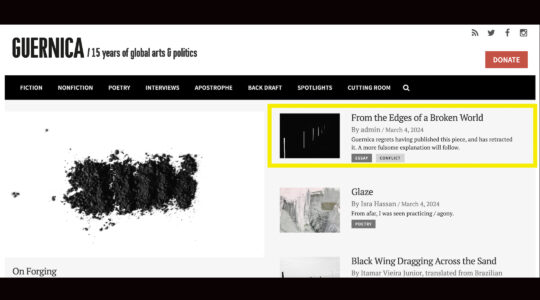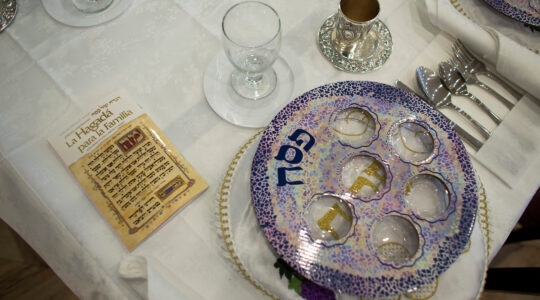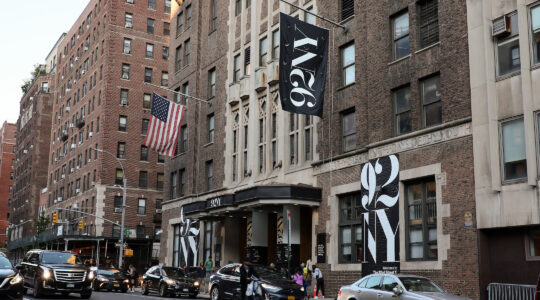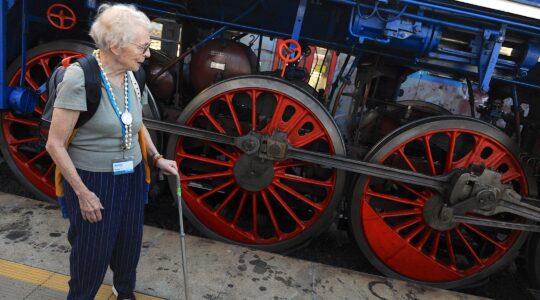SHANGHAI, China (JTA) – Uri Gutman had more than parades and picnics in mind a couple of years ago when the Israeli government allotted funds to its Shanghai consul general for an Israel Independence Day reception.
Gutman wanted to make a bigger impact with a service project in the community.
So he devised a three-step plan to give back to elderly residents of the Hongkou neighborhood, the area made into a “stateless refugees” ghetto during the Japanese occupation during World War II and home to more than 20,000 European Jews fleeing the Nazis.
While the world’s eyes are trained on Beijing for the Summer Olympics, which start Friday, Shanghai’s Jewish history has been spotlighted recently as well.
Many of the refugees reached Shanghai through the heroic efforts of Ho Fengshan, a Chinese diplomat in Vienna who issued thousands of visas to Austrian Jews. Ho was honored with a special tribute in June.
He came to be known as the “Chinese Schindler,” in reference to the German industrialist who saved Jews. Oskar Schindler’s life became the story of an Academy Award-winning film, “Schindler’s List,” by Steven Spielberg.
The consulate and 27 Israeli companies joined to raise approximately $87,000 for Gutman’s project detailing Shanghai’s Jewish past.
The first step was completed in June, a renovation of the Hongkou Elders’ Activity Center in Huoshan Park, around the corner from the site of the former Ohel Moshe synagogue, now the Shanghai Jewish Refugees Museum.
The funds also were used to set up a database, to be housed at the refugees museum, of names and addresses of Shanghai’s Jewish residents. Gutman wants the database to be interactive and eventually include multimedia and information on the whereabouts of descendants.
“Here, after the war, Jews spread all over and there is nothing left, no community, no archives,” Gutman lamented.
Also at the museum in June, the U.S. Commission for the Preservation of America’s Heritage Abroad honored Ho, dedicating a marker in English, Chinese and Hebrew. In cooperation with the Shanghai Academy of Social Sciences, the commission also opened a photo exhibition about Ho’s life and work.
After Austria’s annexation by Germany and Kristallnacht in 1938, many of its 185,000 Jews, most of whom lived in Vienna, needed safe passage out of Europe. Acquiring the necessary documentation proved especially difficult after the 1938 Evian Conference at which 32 countries, including the United States, made it clear they would not stand up to the Nazis.
As the consul general in Vienna from 1938 to 1940, Ho at his own peril sometimes issued as many as 900 visas a month to Jews trying to escape Nazi rule.
Ho’s daughter, Manli, was on hand for the ceremony along with American, Chinese and Israeli officials.
She recalled that one visa recipient, Eric Goldstaub, visited 50 foreign consulates in Vienna before obtaining from her father 20 Chinese visas for himself and his family.
“On Kristallnacht, both Goldstaub and his father were arrested and imprisoned, but with the Chinese visas as proof of emigration, they were released within days and embarked on their journey to China,” Manli wrote in the event’s program.
Not all of the Chinese visa holders from Austria, Europe’s third largest Jewish community, went to China. But those who did entered predominantly in Shanghai, where the open ports enabled them to immigrate with minimal hassle.
Other recipients of Ho’s life-saving visas included those arrested and sent to the Nazi concentration camps Dachau and Buchenwald.
His work was motivated by humanitarian reasons.
“I thought it only natural to feel compassion and to want to help,” Ho once wrote.
Ho acted in defiance of direct orders to desist from his superior, the Chinese ambassador in Berlin, and incurred a subsequent demerit from his own government.
In early 1939, the Nazis confiscated the Chinese consulate building in Vienna, but Ho continued his efforts issuing visas from a smaller facility for which he paid all the expenses himself.
Ho continued his diplomatic career after leaving Vienna in 1940 and moved to San Francisco following his retirement in 1973. In 1990, he published a memoir, “40 Years of My Diplomatic Life.”
His heroism in Vienna mostly went unrecognized during his lifetime. The Republic of China ignored his legacy for many years because he was a member of the KMT Nationalist Party. Meanwhile, he was denied his pension by the nationalist government in Taiwan because he was accused of embezzling a small sum of money.
The accolades would come after his death in 1997. In 2001 he was named “Righteous Among the Nations” by the Yad Vashem Holocaust museum in Jerusalem. In June, the U.S. Senate passed a resolution honoring Ho.
At the Shanghai ceremony, Martin Gold, a member of the U.S. preservation commission, praised Ho by pointing out that 70 years ago most nations, “including my nation, rebuffed the Jews.”
Gold noted that all the Jewish recipients of Chinese visas lived, with many eventually settling in America.
“Dr. Ho’s life was itself a bridge between China and America,” he said in his speech. “No relationship in the world is more important.”





